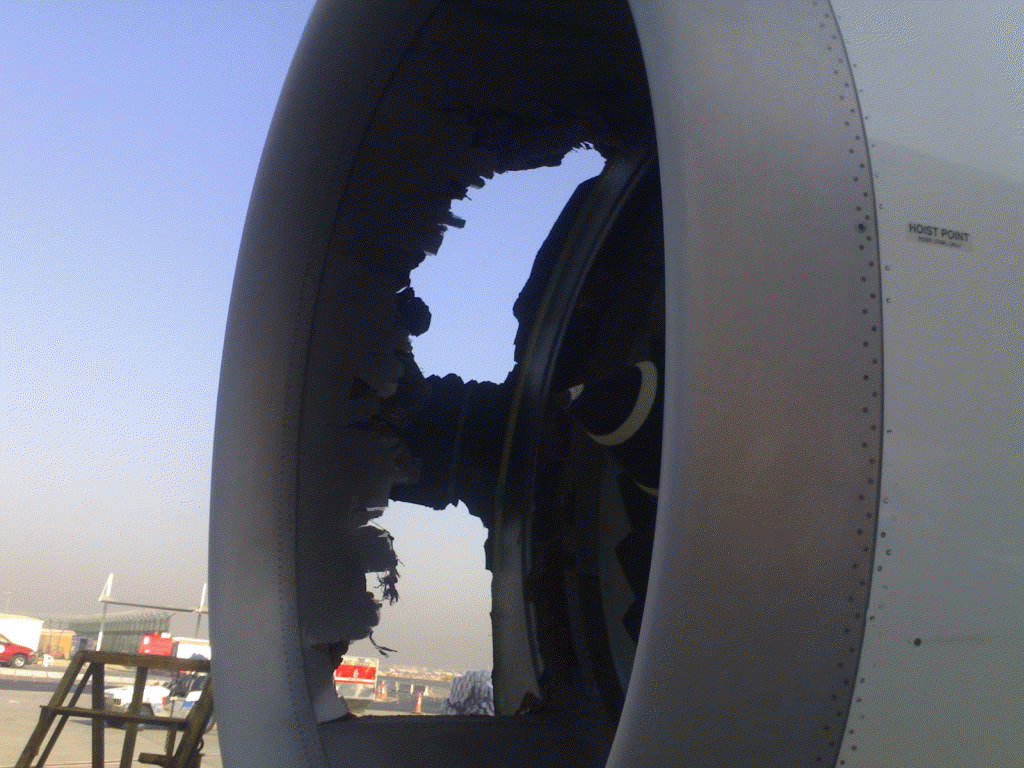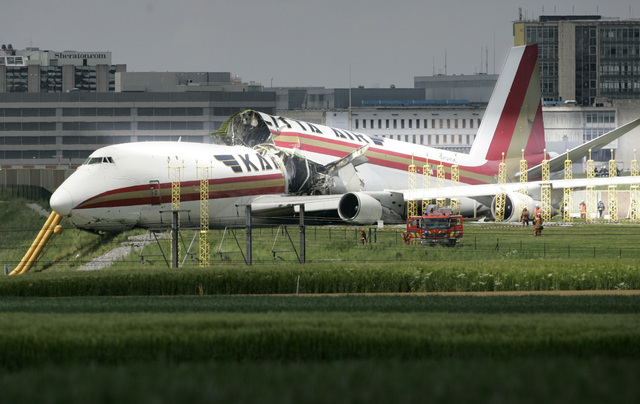http://archives.californiaaviation.org/airport/msg31688.html
"Airport Wildlife Control: Egrets are the biggest threat to pilots"
Monday, August 30, 2004
Egrets are the biggest threat to pilots
Singapore - The Straits Times
MIGRATORY egrets pose the biggest bird-strike threat to airports here,
because of their size.
But it is not just the winged visitors that worry pilots.
Aside from the pigeons, sparrows, swallows, mynahs and plovers, there is
also the occasional visits from wild dogs, monitor lizards, snakes and,
recently at Tengah Air Base, a wild boar as well.
To keep them off the runway, airports take many steps:
Pyrotechnics: Flares are fired that set off two loud bangs which
scare the birds away.
Bird distress calls: A hand-held loudhailer broadcasts
digitally-recorded sounds of birds in distress. There is a choice of
crow, pigeon, mynah, sparrow and osprey. The crow call is also used for
egrets. Changi Airport also uses the calls of predatory birds to scare
off visitors.
Chemical repellant: An SMS from the control tower activates a machine
that sprays a non-toxic chemical extracted from grapes known as methyl
anthranilate, that irritates the mucous membranes of the eyes and mouth
of the bird.
Grass cutting: Grass around the airfield is kept to between 15cm and
20cm for better visibility and to prevent birds from hiding in it.
Closer to the runway, it is longer, between 25cm and 30cm, as it
irritates long-legged fowl such as egrets.
Plugging holes: Holes in the ground are covered so that they do not
collect water which breed mosquitoes and earthworms that attract birds.
Birds of prey: Goshawks, a powerful and persistent hunter whose
presence will spook other birds, is being tried out at Tengah Air Base.
Food control: Changi Airport uses pesticides to cut down the number
of insects in the grass. Garbage is not left in the open and fruit trees
are not planted within the airport.
Hunter birds tackle feathered menace
BirdPark hawk shoos away birds to avoid collision with planes but it
isn't tenacious enough, so plan is to import goshawks
FOWLER the show bird took off on her maiden military flight at Tengah
Air Base in April, on a mission to scare away birds from the runway used
by fighter planes for take-offs and landings.
But the 10-year-old Harris hawk, a predatory bird from the Jurong
BirdPark, failed to live up to expectations.
Now, plans are afoot to import two goshawks from Germany - hunter birds
known for their tenacity and strength.
Not that Fowler did not scare birds away. Circling over the sprawling
airfield in Lim Chu Kang Road, she shooed away groups of crows, swifts
and swallows.
But she was not tenacious enough. Said the executive director of Jurong
BirdPark, Dr Wong Hon Mun: 'She's trained for our show. If the birds fly
away, she won't be bothered to go after them.'
Those manning the airstrip of the Republic of Singapore Air Force (RSAF)
- like others around the world - are on a daily lookout for birds that
could collide with planes.
The feathered menace can dent an aircraft's body or be sucked into its
jet engines, forcing an emergency landing or, worse, bringing it down.
Collision with birds, as well as some deer and other wildlife, killed
more than 150 people globally and destroyed more than 140 planes between
1990 and last year, according to a United States Federal Aviation
Administration report.
US civil aviators lose an estimated US$500 million (S$861 million) a
year to bird strikes, with 5,940 reported cases last year. The US Air
Force lost more than US$50 million to 1,293 bird hits last year.
Changi and Seletar airports see one to two bird strikes in total each
month, involving small birds like swallows, mynahs and munias which do
not damage aircraft, a spokesman for the Civil Aviation Authority of
Singapore told The Straits Times. However, the monthly total is 10 for
the RSAF at its four airbases in Changi, Paya Lebar, Sembawang and
Tengah.
Pilots have felt the shock of birds hitting their aircraft and
technicians have found blood stains and other remains in the jet
engines.
'The worst is some minor damage to the engine, with a nick or two on a
blade, nothing serious,' said Lieutenant-Colonel Penny Ng, the
commanding officer of Tengah Air Base's flying support squadron. 'But
everybody treats it seriously. You simply can't risk life, and the
aircraft are expensive.'
A two-man team patrols the airfield at Tengah and alerts the control
tower on spotting any flock of birds - from pigeons to plovers - which
start warming themselves on the tarmac as the sun rises.
The airbase's biggest worry is the migratory egret that appears between
September and November because it is larger and could cause more damage
in a collision.
To keep them away, it uses a combination of methods - from keeping grass
long in some areas to poke at the long-legged birds, to firing loud
flares followed by pre- recorded bird distress calls from a hand-held
loudhailer.
About three years ago, it also tested a machine that automatically
sprays a chemical that irritates the eyes and mouths of birds.
It worked well, until the birds caught on to the times at which the
chemical was released, said Mr Thomas Fernandez, managing director of
home-grown Pestbusters and sole distributor of the German-made gadget.
The gadget was tweaked so it could be activated by SMS from the control
tower when a flock of birds were spotted on the runway. SMS is used as
other remote-control methods, such as those using radio frequencies,
could interfere with the aircraft. Eight machines now dot the airfield.
At Changi International Airport, measures include preventing birds from
feeding there.
Pesticides are used to reduce the number of insects in the grass. Also,
garbage is not allowed to be left in the open and no fruit trees are
planted.
Still, there are one or two bird strikes a month and Lt-Col Ng is not
satisfied: 'The idea is to bring it down to zero.'
Here is where the goshawks come in: It takes only one of them to clear a
large area of birds. It will be one more tool in the arsenal to keep
birds away - if it works.
Said Lt-Col Ng: 'It still needs a fair bit of fine-tuning. It's very
early days.'
DEADLY COLLISION: PREVIOUS INCIDENTS
SEPT 22, 1995: United States Air Force E-3 Airborne Warning and Control
System aircraft strikes about three dozen geese during take-off in
Alaska. The aircraft crashes in a forest about 1.6km beyond the runway,
killing all 24 crew members.
July 15, 1996: Belgian Air Force C-130 transport plane strikes a flock
of birds when approaching runway in the Netherlands and crashes, killing
34 people on board.
March 8, 2001: A duck crashes through the windscreen of a civilian Bell
206 aircraft transporting a heart patient to a hospital in Montana, in
the US. The pilot is slightly injured and the duck ends up in the
patient's lap.
Dec 6, 2001: A Boeing 737 strikes a flock of gulls on take-off from
Detroit, forcing an emergency landing. The bill to replace the engine
comes to about US$2.3 million (S$3.9 million).
Source: Bird Strike Committee USA.
Attached Photo's:
Birdpark's Fowler (left) did scare away birds at Tengah Air Base but it
lacked persistence.
Another method is to use chemical spray machines, like the one above.
Activated by SMS, it sprays a non-toxic chemical that irritates the eyes
and mouth of birds.
wildlife_control1.jpg
wildlife_control2.jpg











